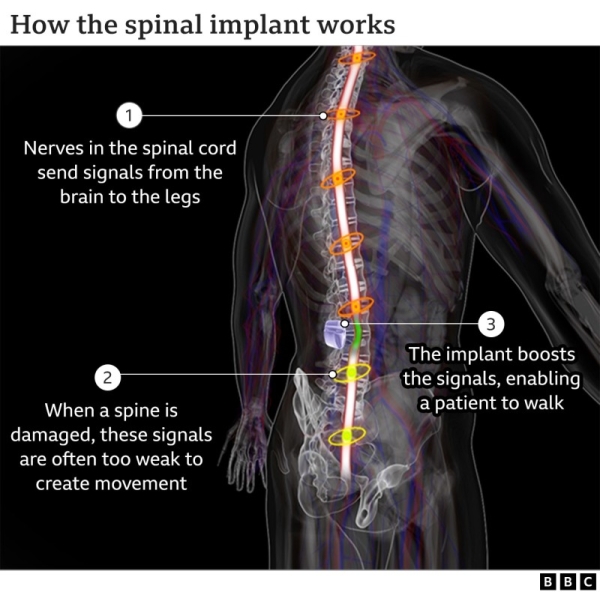In 2017, Michel Roccati was in a motorbike accident that left his lower body completely paralyzed. In 2020, he walked again due to a new spinal cord implant.
The implant sends electrical pulses to his muscles, emulating the action of the brain.
“It was a very emotional experience,” Roccati told journalists of the first time the electrical pulses were activated, and he took a step.
He was one of three patients involved in the study, published in the journal Nature Medicine, all of them unable to move their lower bodies after accidents.
Once the six-centimeter implant was inserted and its pulses were fine-tuned, they were all able to move.
“These electrodes were longer and larger than the ones we had previously implanted, and we could access more muscles thanks to this new technology,” said Jocelyne Bloch, a neurosurgeon at the Lausanne University Hospital who helped lead the trial.

It was definitely a difficult start that required massive upper body strength but the rehabilitation process began right away and within four months Roccati could walk with only a frame for balance.
“It’s not that it’s a miracle right away, not by far,” cautioned Gregoire Courtine, a neuroscientist at the Swiss Federal Institute of Technology who led the research with Bloch.
Roccati is now “able to stand for two hours – he walks almost one kilometer without stopping”.
The three people could climb stairs, swim, and canoe.
The improvements depend on the electrical stimulation, which is triggered via a computer carried by the patient that activates a pattern of pulses.
“What we all think is that if you try earlier, it will have more effect,” she said.
However, there ate some issues like in early recovery, a patient’s capacity is still in flux. This makes it hard for a baseline from which to measure progress, and ongoing medical treatment and pain could hamper rehabilitation.
At this point in time, the implants are only practical for those with an injury above the lower thoracic spinal cord, the section running from the base of the neck to the abdomen, because six centimeters of the healthy spinal cord is needed.
Further applications of the study can also help regulate low blood pressure in spinal cord injury patients and even bring some relief to Parkinson’s patients.
They next plan to miniaturize the computer that activates the pulses so it too can be implanted in patients and controlled with a smartphone.
They expect this to be possible this year, and have plans for large-scale trials involving 50-100 patients in the United States and then Europe.
“We believe there is a bright future for neurological stimulation technology,” said Courtine.
“We’ll do (it) as fast as we can.”


